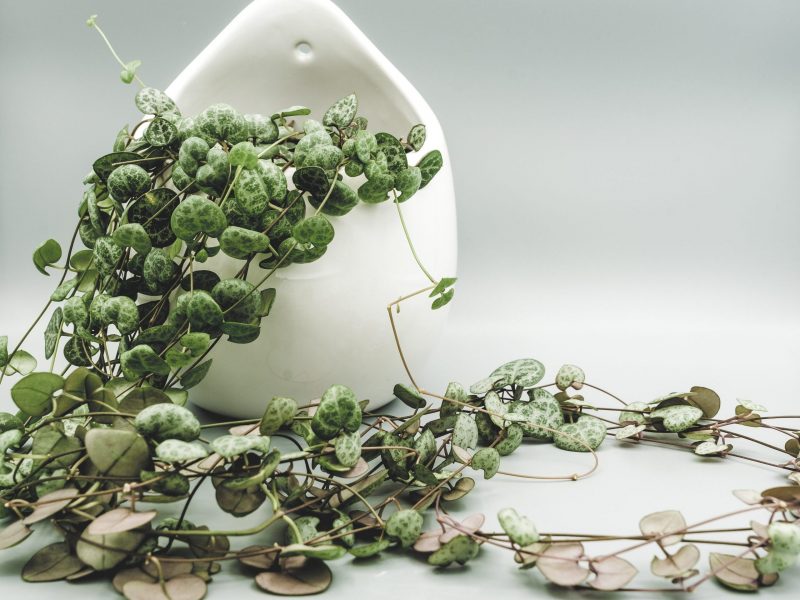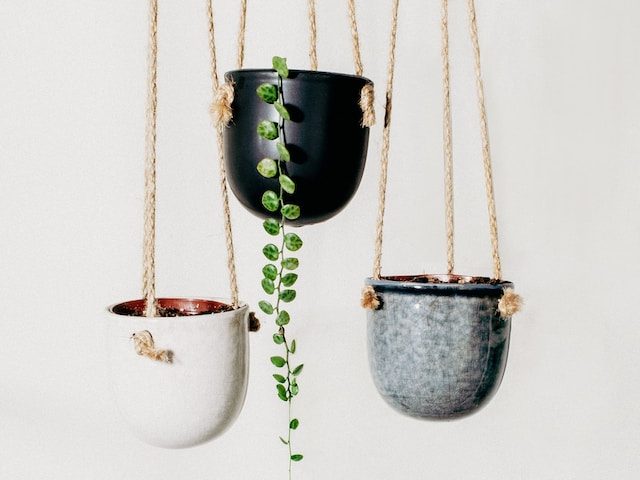
The String of Hearts plant, sometimes known as Rosary vine, is one of the most beautiful but delicate houseplants. Their unique heart-shaped leaves that hang off long, thin vines make them a must-have for any room. However, they can be a little sensitive and react quite strongly when not given the right care. One of the most common problems you may face with String of Hearts plants is yellow leaves. There are several causes for yellow leaves but don’t worry, if you have caught the problem fairly early, there is no reason why you can’t get your plant back to full health soon enough.
Below you’ll find all the reasons why your String of Hearts may have yellow leaves, as well as how to fix the issue and prevent it happening again.
Overwatering is a common cause of yellow leaves
9 times out of 10 your String of Hearts plant will be turning yellow due to overwatering. This problem is also often accompanied by your plant losing leaves. String of Hearts plants hate sitting in soggy soil more than anything and it can quite quickly cause a number of issues for your String of Hearts. The most serious issue it causes is root rot which can happen very quickly as the roots on String of Hearts plants are very delicate and short. This means even the slightest issue in the soil can cause your plant to show signs such as yellow leaves.
Rotting and mushy roots mean that your String of Hearts is unable to take up nutrients and the vines will often fall out of the pot. Waterlogged soil also gives off quite a damp and musty smell so get up close to your plants every so often to check for any smells.
There are a few simple ways to find out if your String of Hearts’ soil is waterlogged:
Take your String of Hearts out of its pot
If there are a significant amount of yellow leaves on your String of Hearts then you probably want to take the plant out of its pot so you can inspect the soil up close. If you feel that it is waterlogged and clumpy then this is definitely the issue causing the yellow leaves.
Finger/Chopstick Method
Firstly, the finger trick where you stick a finger into the soil to see if there is any moisture in the soil. If yes, you’ll notice soil sticking to your finger when you take it out. If the soil is bone dry then it will just be like dust which will fall off your finger. If you don’t want to get your hands dirty then you can also use a chopstick where the same rule applies. If the chopstick comes out clean then it’s time for a water.
Do I risk damaging the root system if I stick my finger in the soil?
As long as you are careful and don’t prod around too much, then you shouldn’t cause too many issues. If you notice a large root in your way, try and pick a different spot rather than forcing the chopstick in as this will break the root.
Picking up your String of Hearts Plant
Another way you can check the moisture levels in the soil is by regularly picking up your plant. This is a great method to get to know your plants and soon you’ll have a really clear gauge as to when they need watering. The lighter the plant is, the less water there is in the soil – pretty simple! Luckily, String of Hearts are very light houseplants as they don’t have thick stems or roots which means picking them up shouldn’t be too difficult but don’t try this with bigger plants as you don’t want to cause injury.
Use a moisture meter
If you want to take the guess work out of knowing when to water your String of Hearts (and prevent more yellow leaves) you can use a moisture meter. You simply pop it in the soil and it will give you a reading of the moisture in the soil. They are super affordable little gadgets which are a great investment for every budding plant parent! We recommend this one which is available at Amazon.
How do I fix a waterlogged String of Hearts?
If the yellow leaves on your String of Hearts are caused by waterlogged soil then it’s super important that you act quickly. Root rot can be damaging to your plant due to the shallow and delicate leaves. Instead of letting the soil dry out naturally, you want to replace it straight away once you notice it is waterlogged. This will prevent any further yellow leaves from developing on your plant and the roots can start to recover and healthy growth should resume soon. Make sure to use a high-quality well-draining potting mix like this one which you can pick up on Amazon.
After replacing the potting mix, prune away all of the yellow leaves. Once they have turned yellow the damage is done and they won’t go back. Pruning off the leaves and stems where the plant is damaged will help your plant recover quicker as it won’t be wasting any energy on trying to keep these dying leaves alive. Instead, it can focus on new healthy growth.
In future, to prevent any more yellow leaves, try to regulate your watering and always check that the top of the soil is dry before giving your String of Hearts any more water. You also need to adjust your watering routine according to the seasons. During the growth period of spring and summer your String of Hearts will require water about every 10 days. However, in winter months about once every month or two is enough as the days are a lot shorter and colder so your plant will be dormant.
Drainage issues can also cause yellow leaves
Sometimes it may not be your watering schedule that is killing your String of Hearts, but the poor draining of the soil and pot.
Add perlite into the potting mix
You can very easily increase the amount of drainage in your String of Hearts’ soil by mixing in a small amount of perlite, this will make it far easier for water to flow through and out of the drainage holes of your pots. Plus you can grab some perlite from Amazon which makes it super easy!
Ensure your pot has drainage holes
It’s very important that your pots have drainage holes so that any excess water can flow out of the pot into either the planter or the saucer. This is a great step to preventing root rot and yellow leaves as your plant won’t be sat in waterlogged soil.
Another easy step is to add a few small stones or pebbles to bottom of your pots, this helps in making sure that the drainage holes are never blocked by soil or any loose debris.
Use clay/ terracotta pots
Although clay or terracotta pots can be a little bit more expensive or breakable, their upsides are much more than just the aesthetic. The clay they’re made of is permeable which means that some of the water in your soil can evaporate through the sides of the pot. This isn’t the case for the plastic pots that most use, which instead hold in all of that moisture. So sometimes it is worth investing a little more to make sure that the roots of your String of Hearts plant isn’t sitting in too much moisture as this will help avoid yellow leaves. Our plants really love these terracotta pots.
Low temperatures can cause yellow leaves on String of Hearts plants
Cold temperatures and drafts can also be very harmful to your String of Hearts. Make sure your plant is not placed near doors or windows that may be drafty. Even though the temperature of your home may be perfect for your String of Hearts and it is receiving a lot of sunlight, the drafts coming in from outside may be colder and harm your plants health.
We recommend picking up a digital thermometer to check the temperature across the day and night in various spots in your home. This will make sure that you don’t place your String of Hearts too close to windows or in places where the temperature really drops at night. They are super affordable and the benefits are definitely worthwhile!
Don’t worry too much if only a few of the leaves on your String of Hearts are starting to turn yellow, it means you caught the issue early. Once you have diagnosed whether it is overwatering, drainage issues or cold temperatures that’s the problem, adjusting your watering routine or moving it to a new spot in your home should help your plant return to full health. If your String of Hearts continues to develop yellow leaves and you can’t find a way to revive it you may want to think about propagating the healthy parts of the plant. Stem cuttings are a great way to grow a new healthy String of Hearts plant and it’s quite a quick process too! Check out our String of Hearts Propagation Guide for everything you need to know.
To find out more about String of Hearts care, common problems and top tips check out our complete String of Hearts care guide.














